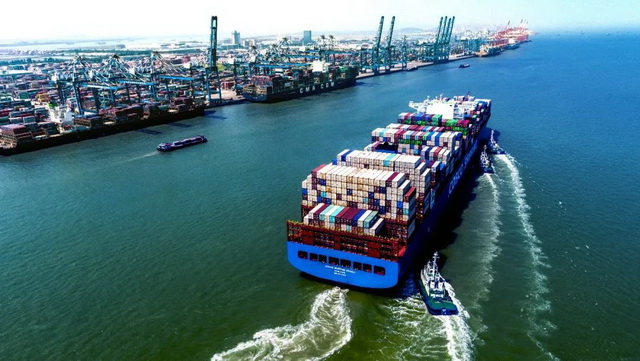Guangzhou Port Group Ushers in a “Good Start”: Three New Foreign Trade Routes Are Added, and A Number of Production Records Are Set (Picture)

There is a good start with the arrival of the new year. Since the beginning of this year, Guangzhou Port has given full play to its advantages as a comprehensive hub port, coordinated port cargo categories, tapped yard potential, accelerated port cargo turnover, and opened up the “last kilometer” of logistics, major cargo categories, such as grain, foreign trade coal and commercial vehicles, have achieved growth to varying degrees, and with the power of the port, the smooth operation of the domestic and international dual cycles around the Spring Festival has been effectively ensured. In January, Guangzhou Port Group’s cargo throughput and container throughput achieved double-digit growth on a year-on-year basis; three new foreign trade routes were added, and Nansha Grains and General Cargoes Company’s grain unloading volume, Xinsha Terminal’s foreign trade vehicle export volume, and the production of Nansha Phase III, Xiaohu Petrochemical Terminal and many other terminals reached a record high in a single month.
Expanding the Network
Since the global pandemic is still on the rise, the pandemic in foreign countries has caused serious port congestion in many ports, and the port and shipping market is facing complex situations, such as poor container turnover and increased difficulty in returning empty containers, Guangzhou Port has insisted on placing equal emphasis on pandemic prevention and control and safe production, strictly implemented prevention and control measures, and actively adapted to the requirements of ongoing pandemic prevention and control to ensure the normal and efficient operation of the terminals.
At the beginning of the new year, Guangzhou Port's foreign trade routes, especially Southeast Asia routes, showed a good growth momentum. Three Asian routes including NCX3 (jointly operated by T.S. LINES and CMA CGM), Asean Seas Line’s BVX2 and SITC SCV were added.
“Integrated Customs Clearance in the Greater Bay Area” is newly extended to Zhongshan Xiaolan Port and Foshan Sanshui Terminal. Plus the previous Nangang Terminal, Jiaoxin Terminal, Sanrong Terminal, Beijiao Terminal, Leliu Terminal, Rongqi Terminal, Yunfu New Port and Zhongshan Port Terminal, “Integrated Customs Clearance in the Greater Bay Area” has covered 10 docking point terminals, building a fast logistics channel from Nansha Port Area to various terminals in the Guangdong-Hong Kong-Macao Greater Bay Area.
Strengthening Production
Facing complex market changes, various terminals of Guangzhou Port have taken the initiative to overcome production difficulties and pain points and strengthen the overall coordination of production resources to ensure the effective connection of various links and guarantee the smooth and orderly production organization of the port area. A number of cargo categories ushered in growth, and a number of terminals hit new production highs in the first month, laying a solid foundation for the start of annual production.
The throughput of commercial vehicles, grains and other cargoes achieved good year-on-year growth. Among them, the export volume of commodity vehicles hit a record high in a single month, and the monthly unloading volume of Nansha Grains and General Cargoes Terminal reached a record high among the terminals of the port.
Xinsha Company ushered in the first 284 used cars exported to Djibouti Port in East Africa by ro-ro ship this year, indicating that the used car export business that has been silent for a whole year due to the pandemic in 2020 is gradually recovering.
Nansha Phase III launched the "Nansha-Zeebrugge” special service, which solves the technical problems of loading and unloading container cargo onto/from general cargo ships at a high level, which is an attempt to solve the problem of lack of containers for customers.
Enhancing the Momentum
Port equipment is an indispensable part of the port for its efficient production and operation. In January, Nansha Phases III and IV of Guangzhou Port received a batch of semi-automated and automated large-scale port machinery and equipment respectively, which attracted the attention of the industry. The arrival of new equipment has created favorable conditions for quality improvement and capacity expansion of the port, and enhanced the momentum for the construction of smart ports in the Guangdong-Hong Kong-Macao Greater Bay Area.
On January 23, Nansha Phase III received the second batch of 4 remote-controlled semi-automated rail-mounted gantry cranes. So far, all the supporting equipment for the first phase of the semi-automated storage yard project of Nansha Phase III has been in place. This batch of rail-mounted gantry cranes removes the traditional driver's cab, and can realize the remote-controlled semi-automated operation function to ensure production efficiency.
On January 30, Nansha Phase IV, the first fully automated container terminal in the Guangdong-Hong Kong-Macao Greater Bay Area, received the first batch of 2 automated single-trolley ship-to-shore container cranes and 4 automated rail-mounted gantry cranes, and in addition, 10 intelligent guided vehicles arrived simultaneously by truck. Nansha Phase IV, which is called the “Guangzhou Plan” of the automated terminal by the industry, will be turned into a benchmark of the new generation of smart ports. (Text by Ke Xia, Picture by Port Media)
News
- Xinsha Company Saw A Year-on-year Increase of 10.55% in Cargo Throughput in the First Quarter (Picture)
- 24,188 TEUs! The world's largest container ship calls at Nansha Port Area of Guangzhou Port (Picture)
- “Nansha-Hengyang” Pulp Special Line Launched (Picture)
- Good Start and Good Progress! Nansha Phase III Production Hit a Good Result (Photo)
- The National Consumption Promotion Month & Guangdong Automobile Consumption Festival Kicks Off in Guangzhou Port (Picture)